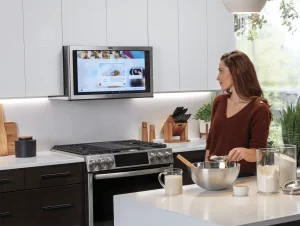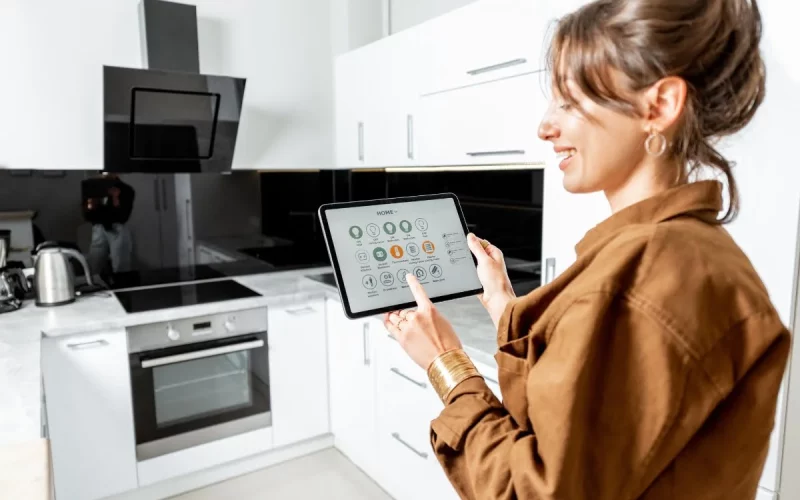Introduction
The smart kitchen appliances market is growing quickly as more people start using connected homes, AI-based cooking tools, and energy-saving devices. In 2024, the market is worth about USD 18.5 billion and is expected to grow to USD 58.0 billion by 2032, with an average yearly growth of 17.2%.
This growth is driven by more homes using automation, stronger demand for energy-efficient products, new features like AI-powered recipes, smart cooking with cameras, and automatic ingredient dispensers. Online shopping and direct-to-customer sales are also helping the market grow.
However, there are some challenges. These include high prices of smart devices, issues with different brands working together, concerns about data privacy, and the need for good customer service after purchase.
Get More Details : https://www.databridgemarketresearch.com/reports/global-smart-kitchen-appliances-market
Market Overview and Definition
Smart kitchen appliances are cooking and food-related devices—like fridges, ovens, stovetops, dishwashers, microwaves, coffee makers, air fryers, multi-cookers, and range hoods—that connect to the internet using Wi-Fi, Bluetooth, or other smart home networks.
These appliances have sensors and software that allow you to control them remotely, save energy, work with voice assistants, track food, get cooking help, and even suggest personalized settings or recipes.
Market Scope and Applications
- Cooking & Baking: Smart ovens, stoves, air fryers, and multi-cookers that have automatic cooking programs, cameras to check if food is done, and can follow recipes automatically.
- Food Preservation & Management: Smart refrigerators that keep track of what’s inside, send alerts when food is about to expire, give nutrition information, and save energy by running at the best times.
- Cleaning & Hygiene: Smart dishwashers that sense how dirty the dishes are, adjust cleaning cycles, and detect leaks.
- Beverage & Small Appliances: Smart coffee makers, kettles, blenders, and nutrition scales that connect to health apps.
- Commercial/HoReCa (Hotels, Restaurants, Cafes): Connected ovens, dishwashers, cold storage monitors, and management dashboards to control multiple locations.
Market Size and Growth Projections
| Year | Market Size (USD Billion) | Growth Rate (%) | Key Drivers |
|---|---|---|---|
| 2021 | 12.1 | — | Post-pandemic home upgrades |
| 2022 | 14.2 | 17.4 | E-commerce penetration, premiumization |
| 2023 | 16.3 | 14.8 | Feature expansion, AI/vision |
| 2024 | 18.5 | 13.5 | Energy efficiency, connectivity |
| 2026 | 26.9 | 20.2 | Wider Matter/Thread adoption |
| 2029 | 40.2 | 14.4 | Mass-market diffusion |
| 2032 | 58.0 | 12.9 | Mature ecosystems, services |
Regional Shares (2024): North America 34%, Europe 29%, Asia-Pacific 28%, Rest of World 9%.
Revenue Segmentation by Product (2024)
- Smart Refrigerators: 28%
- Smart Ovens & Cooktops/Ranges: 18%
- Smart Dishwashers: 14%
- Smart Coffee Makers & Beverage Systems: 10%
- Smart Microwaves: 9%
- Smart Air Fryers/Multicookers/Small Appliances: 8%
- Hoods, Dispensers, Other: 13%
Key Market Drivers
- Home Automation & Lifestyle Shifts: Convenience, time-saving, and premium kitchen upgrades.
- Energy Efficiency & Cost Awareness: Dynamic tariffs and demand-response tie-ins favor connected load management.
- AI/ML and Computer Vision: Guided cooking, doneness detection, automated cycles, and personalization.
- Health & Nutrition Focus: Inventory tracking, allergens, macros, and integration with wellness apps.
- Retail & D2C Expansion: Online configurators, app-based onboarding, and seamless firmware updates.
Market Challenges and Restraints
- High Upfront Cost & Total Cost of Ownership: Premium pricing vs. conventional appliances; repair complexity.
- Interoperability & Fragmentation: Ecosystem lock-in; differing protocols despite growing support for Matter.
- Data Privacy & Cybersecurity: Handling household data, cameras/mics, and remote access securely.
- Reliability & Service Network: Expectations for long product lifecycles and rapid field service.
- User Experience Complexity: Feature-rich devices risk confusing UX if onboarding and support are weak.
Technology Segments
- Connectivity: Wi-Fi (primary), Bluetooth (pairing/local), Zigbee/Z-Wave (legacy hubs), Thread/Matter (interoperability momentum).
- Sensing & Vision: Thermocouples, IR, load cells, humidity, soil sensors, internal cameras for doneness or inventory.
- Software & AI: Recipe parsing, auto-calibration, predictive maintenance, energy optimization, voice assistants.
- Safety & Compliance: Leak detection, child locks, over-temp cutoffs, remote shutdown, HACCP logs in commercial settings.
Detailed Use Case & Application Insights
- Guided Cooking & Auto Programs: Translate recipes to time/temp/fan/steam profiles; reduce failure rates for novice users.
- Inventory & Meal Planning: Fridge cameras, barcode/receipt import, expiry reminders, auto-generated shopping lists.
- Energy Management: Schedule high-load cycles for off-peak; coordinate with home batteries/solar in smart-home ecosystems.
- Commercial Kitchens: Remote diagnostics, fleet firmware updates, menu standardization across sites, energy dashboards.
Market Segmentation
- By Product: Refrigerators; Ovens/Ranges/Cooktops; Dishwashers; Microwaves; Coffee/Beverage Systems; Air Fryers/Multicookers; Hoods & Others.
- By Connectivity: Wi-Fi; Bluetooth; Zigbee/Z-Wave; Thread/Matter-enabled.
- By Distribution: Offline (specialty retail, big box, kitchen studios); Online (brand D2C, marketplaces).
- By End User: Residential; Commercial/HoReCa; Institutional (canteens, healthcare, education).
Regional Insights
- North America: Early adoption, high ARPU, strong smart-home penetration; incentives and energy-management pilots.
- Europe: Emphasis on energy efficiency, sustainability, and safety standards; robust premium segment.
- Asia-Pacific: Fastest volume growth; rising urban middle class, smart apartments, and local manufacturing scale.
- Latin America & Middle East/Africa: Growing from a smaller base; distribution expansion and localized SKUs drive uptake.
Emerging Trends (2025–2032)
- Matter-Native Kitchens: Frictionless setup and multi-brand control standardization.
- Vision-First Cooking: Internal cameras and AI models for texture/color/volume recognition.
- Service & Subscriptions: Premium recipe libraries, auto-replenishment, consumables, and extended warranty bundles.
- Circularity & Repairability: Modular components, refurb programs, and ESG-driven designs.
- Commercial Cloud Platforms: Fleet analytics, energy benchmarking, and HACCP compliance automation.
Competitive Landscape

1. Key Companies
- Samsung, LG Electronics
- Whirlpool, Haier/GE Appliances
- BSH Home Appliances (Bosch/Siemens)
- Electrolux
- Panasonic
- Midea
- Philips Domestic Appliances
- Breville, Xiaomi, Sharp
- Hisense, Sub-Zero/Wolf (select connected models) and a long tail of smart small-appliance brands.
2. Market Structure
- Top global brands leverage multi-category portfolios, software ecosystems, and retail strength.
- Challenger brands drive innovation in small appliances and price disruption online.
- Strategic moves include partnerships with voice assistants, meal-kit services, energy utilities, and smart-home platforms.
3. Common Strategies
- Differentiation via AI cooking, cameras, and energy features.
- Vertical integration of apps, cloud, and after-sales service.
- Localization (voltage, language, recipes) and modular SKUs for price tiers.
SWOT Analysis
| Strengths | Weaknesses |
|---|---|
| Strong value proposition around convenience, precision, and energy savings | Higher upfront cost vs. traditional appliances |
| Rapid innovation cycles (AI/vision, Matter, predictive maintenance) | Interoperability gaps and ecosystem lock-in risks |
| Expanding e-commerce and D2C channels for reach and data | Complexity of UX, onboarding, and support for non-tech users |
| Recurring revenue potential via services and consumables | Dependence on connectivity and cloud reliability |
| Opportunities | Threats |
|---|---|
| Mass-market adoption as costs fall and standards mature | Data-privacy, cybersecurity, and regulatory scrutiny |
| Utility partnerships for demand response and rebates | Macroeconomic downturns delaying kitchen upgrades |
| Commercial/HoReCa fleet platforms and analytics | Supply chain shocks and component shortages |
| Circular economy, refurb, and modular repair programs | Intense competition and price compression online |
Recent Developments and Innovations
- Wider availability of Matter-enabled ovens, fridges, and dishwashers supporting cross-ecosystem control.
- Computer-vision cooking modes that auto-recognize food and set cycles accordingly.
- Energy dashboards and utility integrations for off-peak scheduling and incentives.
- Auto-replenishment for filters, detergents, coffee pods, and water cartridges through brand apps.
- Predictive maintenance alerts reducing downtime and service costs.
Future Outlook (2025–2032)
- Standardization → Scale: As Matter/Thread interoperability expands, setup friction falls and multi-brand kitchens become common.
- AI as a Core Feature: Vision-assisted cooking and adaptive learning become default in mid- to high-tier products.
- Energy-Aware Homes: Appliances coordinate with EV chargers, solar, and batteries to lower bills and emissions.
- Services & Ecosystems: Recurring revenue from content, diagnostics, and consumables complements hardware margins.
- Commercial Digitization: Cloud fleets and analytics spread from QSRs to broader HoReCa segments.
Investment Opportunities
- AI & Vision Platforms: White-label cooking intelligence and analytics for OEMs.
- Energy Services: Demand-response and dynamic-tariff orchestration layers for connected loads.
- After-Sales Tech: Remote diagnostics, parts logistics, and technician enablement tools.
- Mid-Market Value Plays: Feature-right, cost-optimized SKUs for mass adoption.
- Refurb & Circular Programs: Margin-accretive sustainability offerings.
Conclusion
The Smart Kitchen Appliances Market is transitioning from early adopters to the early majority, underpinned by compelling benefits in convenience, precision, and energy efficiency. With an estimated USD 18.5 billion in 2024 scaling to USD 58.0 billion by 2032, vendors that combine interoperable hardware, intuitive software, robust security, and reliable service networks will lead. As standards mature and costs decline, smart functionality will become a default expectation in new kitchen purchases across both residential and commercial settings.












